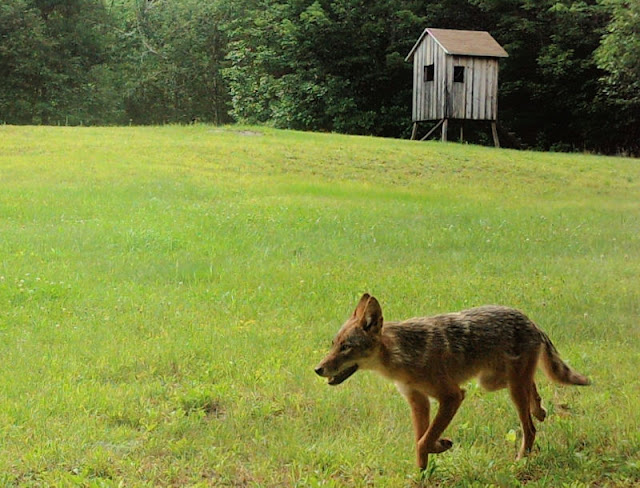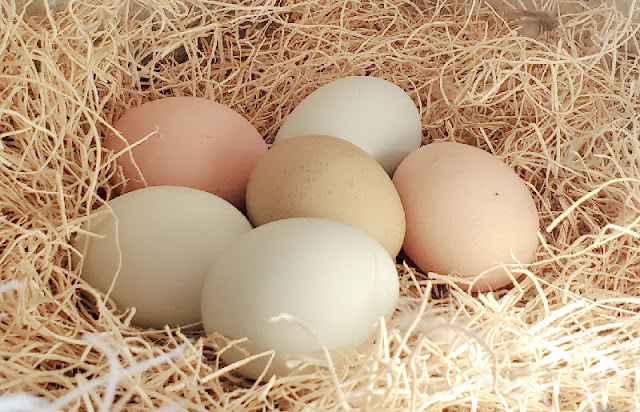Not long after you start keeping chickens, every predator in the neighborhood will have your coop on their radar.
In fact, one of the hardest things about keeping chickens is keeping them safe from predators, but if you can figure out what you're faced with, it can make discouraging, trapping or otherwise dealing with them far easier.
This is clearly not a topic that is pleasant to think - or read - about but as chicken keepers, our responsibility is to keep our chickens safe. No matter what. They're so vulnerable and everything wants to eat chickens!
And even if you keep your chickens safe in an enclosed run, you still don't want wild animals hovering around them - day or night.
Your chickens will get stressed, raccoons will actually try to pull chickens right through the run fencing, and many wild animals can spread disease, not to mention be a potential threat to your children, small dogs or cats.
While most predators including raccoon, coyotes, and owls are mostly nocturnal, there are plenty of other predators out during the daylight hours including fox, dogs and hawks, so if your chickens free range, they are potentially at risk.
And even nocturnal predators will venture out during the day when they're hungry and desperate, or if they sense a free meal.
We have trail cams all over our property and around our chicken coop and it's really amazing to see the predators that are lurking. Most of these photos are actually from our trail cams.
Knock on wood, we haven't had any losses since moving here to Maine, but there's always that chance when you free range.
But the first line of defense is knowing what kind of predators you're potentially going to be dealing with.
How to Identify Common Chicken Predators
Some basic clues might lead you to identifying the predator that's killing your chickens.
Chickens that Go Missing Completely
If a chicken simply disappears, your culprit might very well be one of the following:
Bobcat
Coyote
Fox
Mink
If You're Missing Eggs or Baby Chicks
If your eggs or baby chicks start to go missing, then I would point a finger at one of these predators:
Crow
Skunk
Snake
Rat
If All You're Left with is Chicken Parts
If you find partially eaten chickens, your culprit might be:
Dog
Opossum
Owl
Raccoon
Weasels and Foxes and Hawks Oh My!
Here is a summary of some of the predators you may have to worry about where you live.
Tracks or pawprints in the snow, visual sightings, night vision cameras or, sadly, examining dead chicken carcasses are the best ways to determine which predator is causing trouble.
Bears
Bears, either black or grizzly, are found in forested areas in almost every US state.
Hunting Style: AloneFun Fact | Bears are not generally meat eaters, although in the spring after awaking from hibernation they sometimes will eat small mammals and birds for protein. But usually bears seem content eating only berries, fruit and fish as long as they are plentiful.
Bobcat/Lynx/Cougars/Mountain Lions
Bobcat and lynx are largely found in the western states, but also in other remote areas.
Fun Fact | About twice as large as a house cat, a bobcat won't generally mess with your dog. They're looking for food, not a fight, for the most part.
Cats (feral)
Feral cats found throughout the US in rural and suburban areas alike.
Fun Fact | Feral cats will normally leave full-grown birds alone if there are other food options, and your well-fed house cat won't be a threat to your chickens, although I would keep baby chicks protected. A cat roaming your property isn't a bad thing because it will keep the rodent population under control.
Coyotes
Coyotes are found throughout the US, mostly west of the Mississippi, but increasingly closer to suburban areas, with significant increases in the Southeast.
Fun Fact | Coyotes usually hunt just after dusk or just before dawn and will try to gain access to runs and coops by digging or chewing.
Crows/Ravens
Crows, ravens and magpies are found throughout the US
Fun Fact | On the plus side, crows will chase hawks away from your run.
Dogs
Dogs, both domestic and stray, are a threat to chickens and can found in abundance throughout the US in all types of settings
Fun Fact | Dogs will tear down fencing and doors, chew and dig to get into runs or coops. They are the #1 killer of backyard chickens.
Fisher Cats
Fisher cats are found throughout much of the US, although mainly on the coasts.
Fun Fact | Fishers are the only natural predators in the wild that will take on a porcupine.
Foxes
Foxes are found throughout the US in rural and suburban areas.
Telltale Signs: Kill entire flocks and will typically remove the whole hens one at a time, then keep returning for more that they will bury for future consumption (called 'surplus' or 'cache' killing)
Fun Fact | Free-range hens are at more risk. Foxes generally won't enter a coop or other structure, but will climb into an open-top run or pen area.
Hawks and Eagles
Fun Fact | A hawk usually won't actually carry off a chicken, but will start eating it alive right on the ground. An eagle will carry off a chickens. Unfortunately, both hawks and eagles are protected by federal law and not allowed to be shot, so you'l have to figure something else out to keep your flock safe.
Opossums
Fun Fact | Possums really do play dead, but will hiss and bare their teeth when cornered, and can transmit disease to livestock.
This little guy was prowling around the run and left some pretty unmistakable prints in the mud one night. He was successfully captured and then sent along his way with a stern warning!
Owls
Fun Fact | Owls will enter barns and coops through windows and openings as small as one square foot. They will land on the ground and walk right into open coops.
Raccoons
Raccoon are found throughout the US in rural and suburban areas.
Fun Fact | Raccoons will return to your chicken coop on a schedule, usually every 5-7 days. And remember, they are smart and can open all sorts of deadbolts and latches with their paws. They also love to try to pull chickens out through the fencing.
Rats
Rats are found in abundance throughout the US.
Fun Fact | Rats sometimes will chew beaks, bite legs or eat feathers of sleeping chickens and will try to pull chicks and smaller bantams down their holes.
Snakes
Fun Fact | Even nonvenomous snakes are sometimes constrictors that can squeeze small chickens to death.
Skunks
Fun Fact | You may or may not smell the skunk's odor after it has been in the coop.
Weasels/Mink/Marten
Fun Fact | Weasels and mink can fit through a hole that is only 1-inch in diameter.
Wolves
Fun Fact | Wolves will kill for sport like dogs and sometimes leave an entire flock dead, however free-range chickens are much more at risk as wolves are hesitant to enter pens or runs.
So now that you have some idea of what might be after your chickens and the telltale signs that they've been around, what to do about the predator...
Weasels and Foxes and Hawks Oh My!
The best defense against predators includes the following tips.
Night Time |Lock your chickens in a sturdy wooden or metal coop at night with 1/2" hardware mesh on all open windows and vents and a predator-proof latch on the door (such as a padlock or eyehook with a clasp).
Be sure run fencing is sunk into the ground a couple of inches to prevent nocturnal digging and that your run is also covered on top.
Install NiteGuard solar powered blinking predator lights around the coop and the run to deter predators from even trying to gain access.
Set up Trail Cams
Also setting up a trail cam can be extremely helpful as an early warning system.
Many predators will scope out your run and get a 'lay of the land' for a few nights prior to trying to get in, so that will give you advance notice that they're prowling and you might not want to let your chickens out to free range for a couple of days.
The trail cam will give you a heads up so you can not only identify potential predators but also set up your traps with the correct bait.
I successfully deterred a raccoon attack with it this past spring. He appeared on the trail cam one night, I set the trap the next night and caught him without a single loss of any of our flock OR damage to our run.
Look for Paw Prints
Another good way to figure out what is prowling around is to sprinkle some Diatomaceous earth or flour around your run or on the ramp/steps to your coop and see what kind of footprints appear by the next morning. Here a raccoon has clearly been snooping on the bottom step.
After a snowfall, be sure to get out there and walk around you coop and run to see what's been lurking.
We're always looking for paw prints in the snow to now only figure out what's out there, but how close they're coming to our chicken coop. Here are some coyote prints my husband ran across in the woods.
Day Time |
Keep chickens in a large completely enclosed run made of a sturdy metal fencing with chicken wire, poultry or bird netting across the top. Sink the fencing into the ground 8-12" with an apron that curves outward underground to deter digging. Make sure the run has a secure latch on the door.
Additional Security Measures
Predator pee is a really effective daytime deterrent. Since wolves are the apex predator, I spray Wolf Pee around our coop and run to try to deter all the predators.
Since chickens and ducks don't have a great sense of smell, it doesn't seem to bother them one bit.
Additional security measures might include:
- a rooster
- a dog specifically bred to guard livestock (such as a Great Pyrenees, Anatolian, Akbash, Maremma, Kuvasz or Komondor)
- electric fencing
- playing a radio set to a talk station
- scattering dog feces around the perimeter of the run
- human hair or urine placed around the coop and run area
- alpacas will guard chickens against foxes
- donkeys will run coyotes off your property.
Trapping or Shooting Predators
Before you trap or shoot any animal, be sure and find out what the local laws are, because many predators are protected or there are only certain times of the year when hunting is allowed, although in many areas a wild animal that is causing destruction to livestock can be killed regardless.
So it's important to check with your local law enforcement, animal control or game wardens to find out what the law are where you live. And remember that by removing a certain type of predator, you're leaving that territory open to another to move in. Sometimes the devil you know is better than the devil you don't know.
If you do set traps, be sure your trap is the correct size and baited with the proper bait for the predator you are trying to catch. Live traps like the ones HavaHart sells are the most humane, but be sure you have a plan in place because in some areas it's illegal to trap and release wildlife elsewhere.
Some or all of these additional measures will help keep your flock safe. Because after all, a predator can make mistake after mistake and still eventually persevere....we need only make one mistake to lose a treasured pet or an entire flock.
For more information on Coop and Run Predator Proofing, read here and here.
For more examples of predator prints in the snow.




























